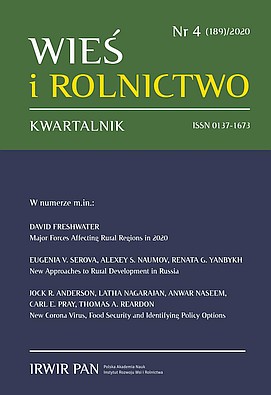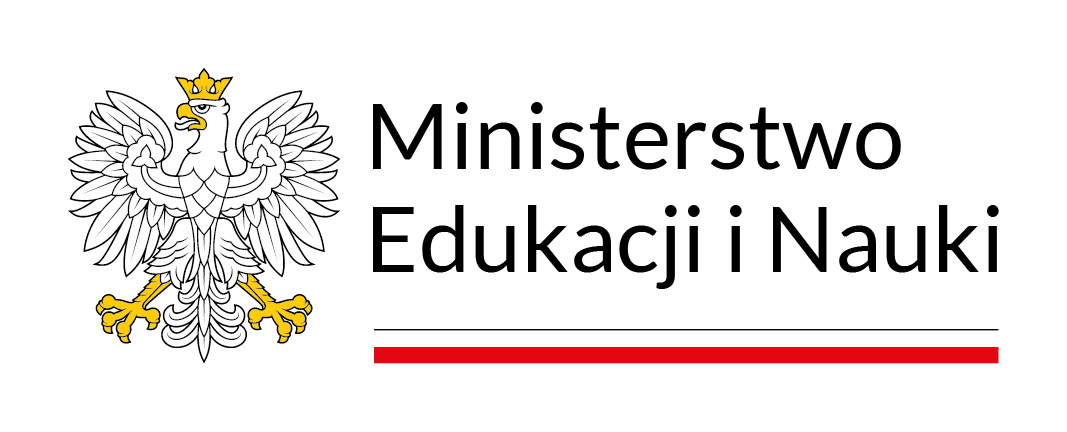Wpływ zmian klimatu na rozwój rolnictwa i obszarów wiejskich w perspektywie roku 2030
DOI:
https://doi.org/10.53098/wir042020/04Słowa kluczowe:
zmiany klimatyczne, rolnictwo, rozwój obszarów wiejskich, studia nad przyszłościąAbstrakt
Zmiany klimatyczne są jednym z największych wyzwań współczesności. W długookresowej perspektywie ludzkość musi osiągnąć neutralność klimatyczną, aby nie doprowadzić do załamania rozwoju cywilizacyjnego. Wymaga to podjęcia znacznego wysiłku mitygacyjnego, aby ograniczyć emisję gazów cieplarnianych. Jednocześnie wraz z upływem czasu i postępującymi zmianami klimatycznymi konieczne są również działania adaptacyjne, które pozwolą ludziom dostosować się do zmieniających się warunków. Niektóre kraje, w tym te należące do Unii Europejskiej, podejmują wysiłki, aby osiągnąć cel neutralności klimatycznej. Wiąże się to ze znacznym wysiłkiem finansowym i organizacyjnym. Celem artykułu jest wskazanie zmian w rolnictwie i na obszarach wiejskich, które mogą mieć miejsce w perspektywie roku 2030 oraz zastosowania polityk mitygujących i dostosowawczych. Artykuł został napisany na podstawie dostępnej literatury.
Bibliografia
Abrol Y.P., Ingram K.T. (1996). Effects of higher day and night temperatures on growth and yields of some crop plants. In: F. Bazzaz, W. Sombroek (eds.), Global Climate Change and Agricultural Production. Direct and Indirect Effects of Changing Hydrological, Pedological and Plant Psychological Processes. Rome: Food and Agriculture Organization of United Nations. http://www.fao.org/3/w5183e08.htm
Babinszky L., Halas V., Verstegen M.V.A. (2011). Impacts of climate change on animal production and quality of animal food products. In: H. Kheradmand, J. Blanco (eds.), Climate Change: Socioeconomic Effects, (pp. 165–190). Rijeka: IntechOpen. DOI: https://doi.org/10.5772/23840
CAKE (Centrum Analiz Klimatyczno-Energetycznych) (2020). The European Green Deal Impact on the GHG’s Emission Reduction Target for 2030 and on the EUA Prices. Warszawa: Centrum Analiz Klimatyczno-Energetycznych, Krajowy Ośrodek Bilansowania i Zarządzania Emisjami, Instytut Ochrony Środowiska – Państwowy Instytut Badawczy.
Cho S.J., Ding J., McCarl B.A., Yu C.-H. (2011). Economic impacts of climate change on agriculture: Adaptation and vulnerability. In: H. Kheradmand, J. Blanco (eds.), Climate Change: Socioeconomic Effects, (pp. 307–324). Rijeka: IntechOpen.
Conway G. (2012). One Billion Hungry: Can We Feed the World? Ithaca: Cornell University Press. DOI: https://doi.org/10.7591/9780801466083
EC (European Commission) (2018). Communication from the Commission to the European Parliament, the European Council, the Council, the European Economic and Social Committee and the Committee of the Regions. A Clean Planet for all A European strategic long-term vision for a prosperous, modern, competitive and climate neutral economy. COM(2018) 773 final, 28.11.2018. Brussels: European Commission.
EC (European Commission) (2019). Communication from the Commission to the European Parliament, the European Council, the Council, the European Economic and Social Committee and the Committee of the Regions, The European Green Deal. COM(2019) 640 final, 11.12.2019. Brussels: European Commission.
EC (European Commission) (2020a). Communication from the Commission to the European Parliament, the Council, the European Economic and Social Committee and the Committee of the Regions. A Farm to Fork Strategy for a fair, healthy and environmentally-friendly food system. COM(2020) 381 final, 20.5.2020. Brussels: European Commission.
EC (European Commission) (2020b). Communication from the Commission to the European Parliament, the European Council, the European Economic and Social Committee and the Committee of the Regions, EU Biodiversity Strategy for 2030. Bringing nature back into our lives. COM(2020) 380 final, 20.05.2020. Brussels: European Commission.
EC (European Commission) (2020c). Inception Impact Assessment Amendment of the Land Use. Land Use Change and Forestry Regulation (EU) 2018/841. Ref. Ares(2020)6081753 – 29/10/2020. Brussels: European Commission.
EUCO (European Council) (2020). European Council meeting (10 and 11 December 2020) – Conclusions. EUCO 22/20, CO EUR 17 CONCL 8, Brussels, 11 December 2020. Brussels: European Council.
Eurostat (2020). Air Emissions Accounts by NACE Rev. 2 activity (NV_AC_AINAH_R2). Luxemburg: Eurostat. https://ec.europa.eu/eurostat/databrowser/view/env_ac_ainah_r2/default/table?lang=en
FAO (Food and Agriculture Organization) (2011). Potential Effects of Climate Change on Crop Pollination. Rome: Food and Agriculture Organization of United Nations.
FAO (Food and Agriculture Organization) (2020). The Contribution of Agriculture to Greenhouse Gas Emissions. Rome: Food and Agriculture Organization of United Nations. http://www.fao.org/economic/ess/environment/data/emission-shares/en/
Hatfield J.L., Prueger J.H. (2015). Temperature extremes: Effect on plant growth and development. Weather and Climate Extremes, 10, 4–10. DOI: https://doi.org/10.1016/j.wace.2015.08.001
IPCC (Intergovernmental Panel on Climate Change) (2007). Climate Change 2007: The Physical Science Basis. Contribution of Working Group I to the Fourth Assessment Report of the Intergovernmental Panel on Climate Change Published for the Intergovernmental Panel on Climate Change. [S. Soloman, D. Qin, M. Manning, M. Marquis, K. Averyt, M.M.B. Tignor, H.J. Miller, Z. Chen (eds.)], Intergovernmental Panel on Climate Change. Cambridge – New York: Cambridge University Press. DOI: https://doi.org/10.1017/CBO9780511546013
IPCC (Intergovernmental Panel on Climate Change) (2013). Climate Change 2013: The Physical Science Basis. Contribution of Working Group I to the Fifth Assessment Report of the Intergovernmental Panel on Climate Change [Stocker, T.F., D. Qin, G.-K. Plattner, M. Tignor, S.K. Allen, J. Boschung, A. Nauels, Y. Xia, V. Bex, P.M. Midgley (eds.)]. Intergovernmental Panel on Climate Change. Cambridge – New York: Cambridge University Press. DOI: https://doi.org/10.1017/CBO9781107415324
IPCC (Intergovernmental Panel on Climate Change) (2014). Climate Change 2014: Synthesis Report. Contribution of Working Groups I, II and III to the Fifth Assessment Report of the Intergovernmental Panel on Climate Change [Core Writing Team, R.K. Pachauri, L.A. Meyer (eds.)]. Geneva: Intergovernmental Panel on Climate Change.
IPCC (Intergovernmental Panel on Climate Change) (2019). Climate Change and Land: An IPCC Special Report on Climate Change, Desertification, Land Degradation, Sustainable Land Management, Food Security, and Greenhouse Gas Fluxes in Terrestrial Ecosystems [P.R. Shukla, J. Skea, E. Calvo Buendia, V. Masson-Delmotte, H.-O. Pörtner, D. C. Roberts, P. Zhai, R. Slade, S. Connors, R. van Diemen, M. Ferrat, E. Haughey, S. Luz, S. Neogi, M. Pathak, J. Petzold, J. Portugal Pereira, P. Vyas, E. Huntley, K. Kissick, M. Belkacemi, J. Malley, (eds.)]. In press.
IUNG (Instytut Uprawy Nawożenia i Gleboznawstwa) (2020). System Monitoringu Suszy Rolniczej: Komentarz agrometeorologa. Dane za lata 2011–2020. Instytut Uprawy Nawożenia i Gleboznawstwa – Państwowy Instytut Badawczy http://www.susza.iung.pulawy.pl/komentarz/
Kleer J. (2018). Cywilizacja i jej cechy charakterystyczne In: J. Kleer, E. Mączyńska (eds.), Państwo w warunkach przesileń cywilizacyjnych, (pp. 21–45). Forecasts Committee “Poland 2000 Plus” of the Polish Academy of Sciences. Warsaw: Polish Academy of Sciences.
Kleer J. (2019). Jaka przyszłość Europy? In: P. Kozłowski, K. Prandecki (eds.), Gdzie jesteśmy, dokąd zmierzamy?, (pp. 37–58). Forecasts Committee “Poland 2000 Plus” of the Polish Academy of Sciences. Warsaw: Polish Academy of Sciences.
Klimada 2.0 (2020). Indicators. Warsaw: Institute of Environmental Protection National Research Institute. Retrieved from: https://klimada2.ios.gov.pl/wskazniki/ (accessed: 27.01.2021).
Konca-Kędzierska K. (2019). Ocena odtworzenia pól opadu w modelach klimatycznych z projektu EURO-CORDEX dla obszaru Polski. In: L. Chojnacka-Ożga, H. Lorenc (eds.), Współczesne problemy klimatu Polski, (pp. 173–186). Warsaw: Instytut Meteorologii I Gospodarki Wodnej – Państwowy Instytut Badawczy.
Martenson C. (2011). The Crash Course: The Unsustainable Future of our Economy, Energy, and Environment. Chichester: John Wiley and Sons. DOI: https://doi.org/10.1002/9781119200918
Meehl G.A., Stocker Th., Collins W., Friedlingstein P., Gaye A.T., Gregory J.M., Kitoh A., Knutti R., Murphy J.M., Noda A., Raper S.C.B., Watterson I.G., Weaver A.J., Zhao Z. (2007). Global climate projections. In: S. Soloman, D. Qin, M. Manning, M. Marquis, K. Averyt, M.M.B. Tignor, H.J. Miller, Z. Chen (eds.), Climate Change 2007: The Physical Science Basis. Contribution of Working Group I to the Fourth Assessment Report of the Intergovernmental Panel on Climate Change Published for the Intergovernmental Panel on Climate Change. Intergovernmental Panel on Climate Change. New York: Cambridge University Press.
MŚ (Ministerstwo Środowiska) (2013). Strategiczny plan adaptacji dla sektorów i obszarów wrażliwych na zmiany klimatu do roku 2020 z perspektywą do roku 2030. Warsaw: Ministerstwo Środowiska.
Nardone A., Ronchi B., Lacetera N., Ranieri M.S., Bernabucci U. (2010). Effects of climate change on animal production and sustainability of livestock systems. Livestock Science, 130 (1–3), 57–69. DOI: https://doi.org/10.1016/j.livsci.2010.02.011
Randers J. (2012). 2052 A Global Forecast for the Next Forty Years. White River Junction: Chelsea Green Publishing.
Sharratt B.S., Tatarko J., Abatzoglou J.T., Fox F.A., Huggins D. (2015). Implications of climate change on wind erosion of agricultural lands in the Columbia plateau. Weather and Climate Extremes, 10 (A), 20–31. DOI: https://doi.org/10.1016/j.wace.2015.06.001
Strużewska J., Jefimow M., Jagiełło P., Kłeczek M., Sattari A., Gienibor A., Norowski A., Durka P., Walczak B., Drzewiecki P. (2020). Zmiany temperatury i opadu na obszarze Polski w warunkach przyszłego klimatu do roku 2100. Warsaw: Instytut Ekonomiki Rolnictwa i Gospodarki Żywnościowej – Państwowy Instytut Badawczy.
Thackeray S.J., Sparks T.H., Burthe S., Bacon P.J., Bell J.R., Botham M.S., Brereton T.M., Bright P.W., Carvahlo L., Clutton-Brock T., Dawson A., Edwards M., Elliot J.M., Harrington R., Johns D., Jones I.D., Jones J.T., Leech D.I., Roy D.B., Scott W.A., Smith M., Smithers R.J., Winfield I.J., Wanless S. (2010). Trophic level asynchrony in rates of phenological change for marine, freshwater and terrestrial environments. Global Change Biology, 16 (12), 3304–3313. DOI: https://doi.org/10.1111/j.1365-2486.2010.02165.x
Toffler A. (1984). The Third Wave. New York: Bantam Books.
UNFCCC (United Nations Framework Convention on Climate Change) (2015). Adoption of the Paris Agreement. 21st Conference of the Parties. Paris: United Nations. https://unfccc.int/sites/default/files/english_paris_agreement.pdf
Wang X., Piao S., Ciais P., Li J., Friedlingstein P., Koven Ch., Chen A. (2011). Spring temperature change and its implication in the change of vegetation growth in North America from 1982 to 2006. Proceedings of the National Academy of Sciences, 108 (4), 1240–1245. DOI: https://doi.org/10.1073/pnas.1014425108
von Weizsäcker E.U., Wijkman A. (2018). Come On! Capitalism, Short-termism, Population and the Destruction of the Planet – A Report to the Club of Rome. New York: Springer Nature. DOI: https://doi.org/10.1007/978-1-4939-7419-1
Westra S., Alexander L.V., Zwiers F.W. (2013). Global increasing trends in annual maximum daily precipitation. Journal of Climate, 26, 3904–3918. DOI: https://doi.org/10.1175/JCLI-D-12-00502.1
Wilkin J. (2020). Agriculture vs. climate. Zagadnienia Ekonomiki Rolnej, 365 (4), 180–186.
Wrzaszcz W., Prandecki K. (2020). Agriculture and the European Green Deal. Zagadnienia Ekonomiki Rolnej, 365 (4), 156–179. DOI: https://doi.org/10.30858/zer/131841
Wypych A., Sulikowska A., Ustrnul Z., Czekierda D. (2017). Variability of growing degree days in Poland in response to ongoing climate changes in Europe. International Journal of Bioclimatology, 61, 49–59. DOI: https://doi.org/10.1007/s00484-016-1190-3











